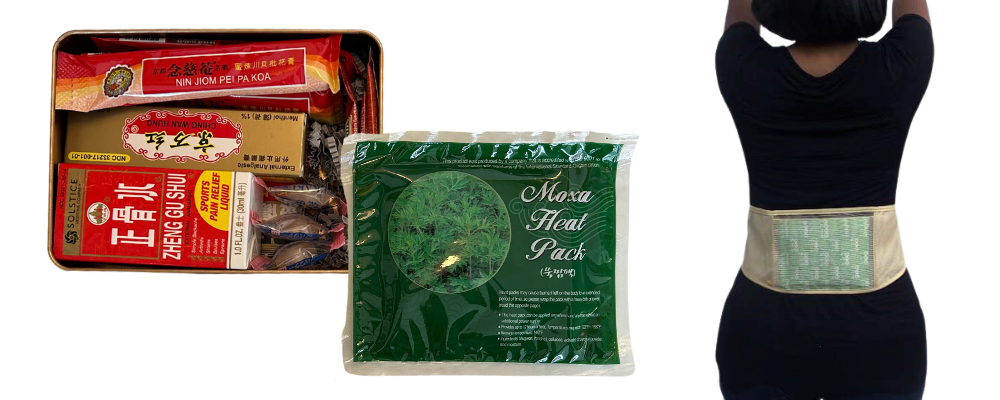‘Notes from the Apothecary’: Mugwort Musings
Ài yė, commonly known as mugwort, hails from the category of Herbs that Regulate the Blood. The most popular product containing Ài yė is in the form of moxa packs that contain loose herbs that will warm with the goal of helping decrease menstrual cramping, soothe low back pain, or warm cold hands.
Ài yė (Artemisiae argyi Folium)
Ài yė, commonly known as mugwort, hails from the category of Herbs that Regulate the Blood. Ài yė is a warming herb that can be used internally as a part of herbal medicine formulas often used for gynecological needs to stop uterine pain or support fertility as the acrid flavor helps to disperse warmth throughout the body and the bitter flavor helps to condense and drain excess dampness within the body.
In everyday East Asian medicine practice, the herbalists at Five Point are often burning a compressed version of Ài yė to use externally in the form of pole moxa to help a pregnant patient turn a fetus in the breech position or with Ibuki moxa to warm specific points to increase circulation and support the immune system. The most popular product containing Ài yė is in the form of moxa packs that contain loose herbs that will warm with the goal of helping decrease menstrual cramping, soothe low back pain, or warm cold hands.
This is a product that is nice to have in your home apothecary, and is included in our Five Point First Aid Kit alongside other helpful products helpful to have ready for use. Please ask your practitioner about moxa packs or other Ài yė products to see if they could be supportive tools for your treatment goals as we transition seasons from Winter to Spring.
All proceeds from our Apothecary items will directly support developing more community education and sliding scale seasonal offerings in the months to come. As always, we appreciate your support!
Taming the Sea of Blood
Learn to read your body’s signs of balance and imbalance by understanding your period better.
For People with Periods
By Julia MacGlashan, L.Ac
Your menstrual cycle is an elaborate balancing act of hormones in constant states of waxing and waning. Imbalances at any stage can cause disruptions in your mood, sleep, energy, skin, pain etc. For many folks, it takes roughly 3-6 months of treatment to regulate hormones. Ever wonder why your acupuncturist suggested weekly treatments during this time? The cycle has four stages, which works out to roughly one per week. See below to get an idea of what’s happening at each stage.
Stage 1: BLOOD
The first day of your period is Day 1 of your menstrual cycle. Hormones are relatively low here. Your body’s Chong Mai (“Sea of Blood,” a splendid name) opens the floodgates. The quality of this blood (color, thickness, clots, amount, and rate of flow) provides so much information on how your body is doing overall. Your practitioner will definitely ask about this. Acupuncture and herbs at this stage help move and replenish blood. Treatment is especially good at this time if you get any cramps or headaches during your period or have a lot of clots.
Stage 2: YIN
Follicle Stimulating Hormone (FSH) tells an ovarian follicle to develop, maturing an egg and increasing estrogen. The estrogen then tells your body to rebuild the uterine lining. This is perhaps the most important stage if you’re trying to get pregnant- definitely don’t skip your treatment this week. Acupuncture and herbs will support yin and jing (reproductive essence). Once estrogen (yin) builds to a certain level, Luteinizing Hormone (LH) triggers ovulation (yang). This is literally yin transforming into yang.
Stage 3: YANG
After ovulation, the empty follicle that released the egg produces progesterone (literally pro-gestation) to stabilize the uterine lining, making it the perfect thickness for implantation of a fertilized egg. Yang continues to build with progesterone, so acupuncture and herbs at this stage will help support yang. The transition from yin to yang is a major hormone shift that should happen smoothly, but can be easily disrupted by things like emotional stress. Mid-cycle symptoms are just as common as PMS.
Stage 4: QI
Implantation occurs here, so this is important if you’re trying to get pregnant. If there IS a pregnancy, your practitioner will incorporate qi and yang tonifying acupuncture and herbs to help maintain your progesterone levels. If there’s no pregnancy, your hormone levels will drop back down and the cycle begins again with the Sea of Blood. Treatments will focus on moving qi to help prevent premenstrual symptoms. If you regularly experience symptoms of PMS or PMDD, this is the most important stage for treatment.
So there you have it, the menstrual cycle in a nutshell. If you have any questions about how hormonal imbalances could be affecting you, or how to incorporate that into your treatments, just ask your acupuncturist!



